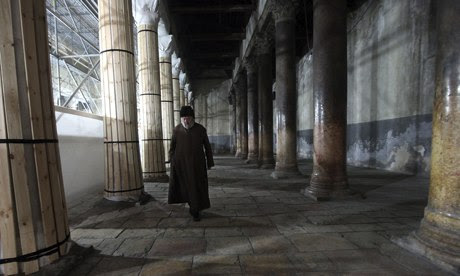Israel Defence Forces deploy 'selfie squad' to improve image
Combat camera unit 'here to explain and to document for the entire world that we don't use force for bad'
______________________________
theguardian.com, Friday 27 December 2013 13.12 GMT
Matthew Kalman in Jerusalem
theguardian.com, Friday 27 December 2013 13.12 GMT
______________________________


Palestinian
protester Mustafa Tamimi lies fatally injured after IDF troops fired a
teargas canister at him in 2011. Photograph: Haim Schwarczenberg/AP
Having suffered a PR battering from viral video clips showing its soldiers in an unflattering light, the Israel Defence Forces are firing back with a combat camera unit trained to show their side of the story.
The
first round of graduates - all combat soldiers - have completed a
seven-month training programme before joining front-line units. Private
Ido H, one of the new "selfie squaddies", has trained for more than a
year as a combat soldier and videographer. He can film, edit and
broadcast from the battlefield.
"My
main mission is to film. I think the job of anyone recording what
happens is much more important than any fighter," he told the Guardian.
"There are lots of cameras on the other side. They show us apparently
acting in an unfair way to civilians, to our enemies. We are here to
explain and to document for the entire world that we don't use force for
bad."
In recent years, cameras wielded by human rights groups
have focused unwelcome attention on the IDF. The Israeli human rights
group B'Tselem has distributed cameras to Palestinians and collected
hours of footage documenting life under occupation. Palestinians say
they are sometimes the only effective weapon against an army equipped
with tanks and fighter jets.
Last
April, Lt Col Shalom Eisner was suspended after he was filmed striking a
Danish protester in the face with his M16 rifle. Video showing Mustafa
Tamimi apparently dying after being hit by a teargas canister during a
West Bank demonstration in December 2011 has helped sustain pressure for
an inquiry.
But
the IDF says videos can be tendentious. In July, human rights groups
assailed the army over film of a five-year-old boy and his father being
arrested and blindfolded after he threw stones at Israeli cars in
Hebron. The army argued the editing failed to show what they described
as an hours-long effort to return the boy safely to his family via the
Palestinian police.
Major
Micha Ohana, the new unit's commander, denied his soldiers were being
trained in disinformation. "If there are errors or other things we will
present them and if necessary we will apologise or explain. But of
course we won't blur, or lie or say they didn't happen," Ohana said.
B'Tselem
welcomed the new unit. "More documentation is a very positive thing,"
said B'Tselem spokeswoman Sarit Michaeli. "There are a lot of arguments
about the facts of various incidents. The problem is that the army
doesn't release this footage and when it does, it releases very heavily
edited sequences."
Haitham
Katib, a Palestinian who has spent eight years filming protests against
attempts to build Israel's security barrier through the middle of his
village farmland in Bil'in, said cameras helped everyone.
"I
feel that my camera can stop some of the violence," said Haitham Katib.
"If the soldiers see you filming, they stop their violence. Sometimes
they broke my camera. They stopped me filming many times. They shoot me
sometimes with rubber bullets. But 70% I believe my camera has stopped
the violence."
Katib said Israeli soldiers had started to film him while he was filming them.
"It's
like we're fighting with cameras," he said. "I would like everyone to
use a camera. It means we are searching for the truth."













